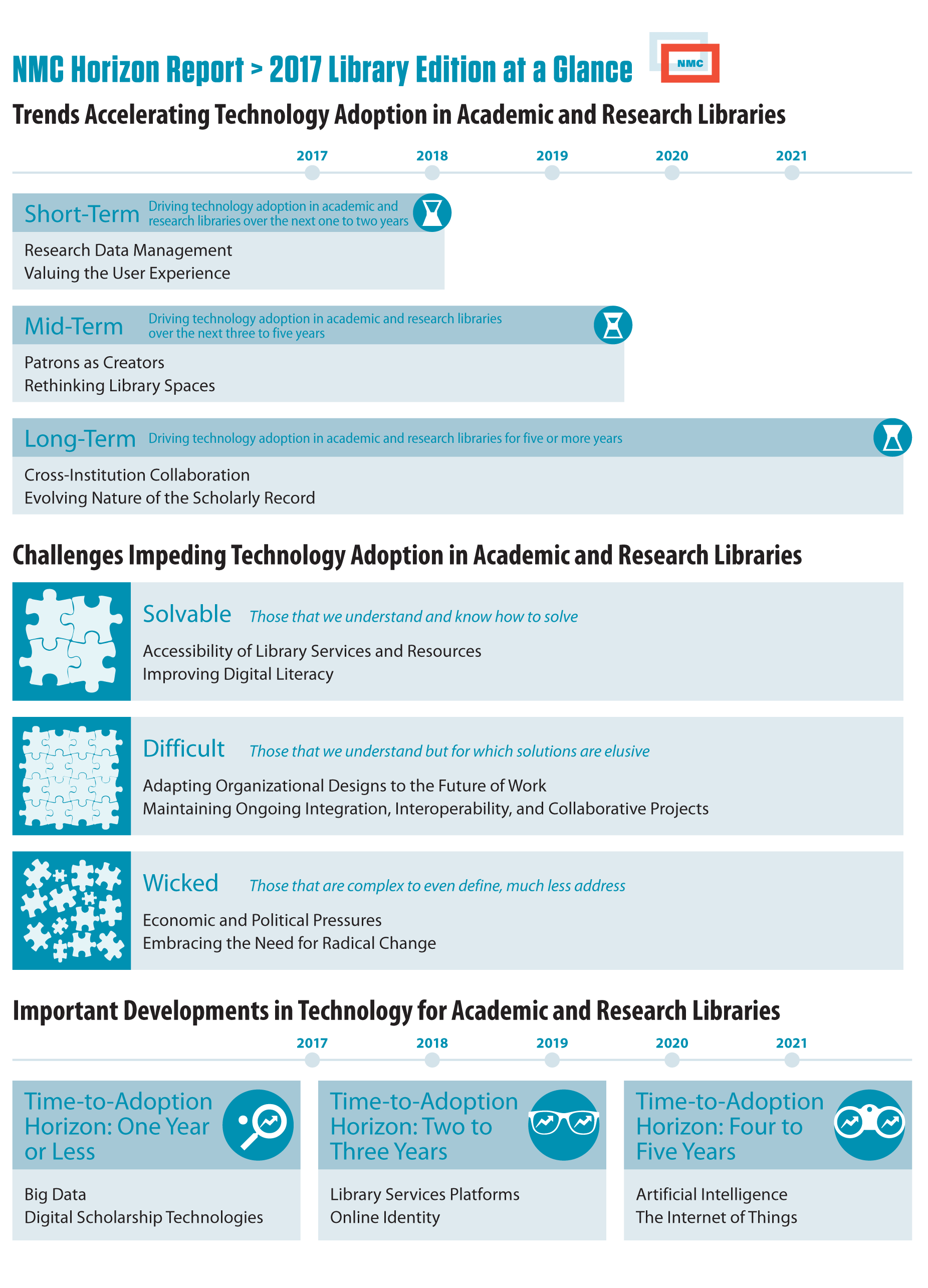Spreading digital fluency is now a core responsibility of academic libraries, and Artificial Intelligence and the Internet of Things (IoT) are poised to amplify the utility and reach of library services like never before. These are just two of the revelations part of the New Media Consortium’s (NMC) University of Applied Sciences (HTW) Chur, Technische Informationsbibliothek (TIB), ETH Library, and the Association of College & Research Libraries’ (ACRL) Annual Horizon Report: 2017 Library Edition.
The report, which decides the trends and technologies that will have a dramatic influence on academic libraries in the next 5 years—thanks to a panel of 75 experts composed of library leaders, librarians, technologists, industry leaders, and other key stakeholders from 14 countries—aims to help leaders seeking inspiration, models, and tactical insight around strategy and technology deployment for academic libaries.
Watch the Video Summary:
“We are invigorated that the partnerships behind our library report have grown even stronger over three editions,” said Eden Dahlstrom, executive director of the NMC, in a statement. “Academic and research libraries are not just a vital part of scholarship, but also advancing knowledge and society as a whole. They play an important role as curators and purveyors of high-quality research, supported by innovative infrastructure.”
Key Trends Accelerating Technology Adoption
According to the report, the trends that will affect technology use and adoption in academic libraries are:
(Short-Term, 1-2 years):
- Research Data Management: The growing availability of research reports through online library databases is making it easier for students, faculty, and researchers to access and build upon existing ideas and work. “Archiving the observations that lead to new ideas has become a critical part of disseminating reports,” says the report.
- Valuing the User Experience: Librarians are now favoring more user-centric approaches, leveraging data on patron touchpoints to identify needs and develop high-quality engaging experiences.
(Mid-Term, 3-5 years):
- Patrons as Creators: Students, faculty, and researchers across disciplines are learning by making and creating rather than by simply consuming content. Creativity, as illustrated by the growth of user-generated videos, maker communities, and crowdfunded projects in the past few years, is increasingly the means for active, hands-on learning. People now look to libraries to assist them and provide tools for skill-building and making.
- Rethinking Library Spaces: At a time when discovery can happen anywhere, students are relying less on libraries as the sole source for accessing information and more for finding a place to be productive. As a result, institutional leaders are starting to reflect on how the design of library spaces can better facilitate the face-to-face interactions.
(Long-Term, 5 or more years):
- Cross-Institution Collaboration: Within the current climate of shrinking budgets and increased focus on digital collections, collaborations enable libraries to improve access to scholarly materials and engage in mission-driven cooperative projects.
- Evolving Nature of the Scholarly Record: Once limited to print-based journals and monographic series, scholarly communications now reside in networked environments and can be accessed through an expansive array of publishing platforms. “As different kinds of scholarly communication are becoming more prevalent on the web, librarians are expected to discern the legitimacy of these innovative approaches and their impact in the greater research community through emerging altmetrics tools,” notes the report.
(Next page: The 6 influential technologies on the academic library horizon)
Important Developments in Ed-Tech in Higher Ed
According to the report, due to the trends currently affecting academic libraries, the technologies that all libraries should take note of include:
(Short-Term, 1-2 years):
- Big Data: Libraries are ideally situated to serve academia, government, and business as information collectors, curators, and analysts. In particular, says the report, “libraries can serve an integral function as collaborators and enable education institutions to make informed decisions that reflect and serve real learner needs.”
- Digital Scholarship Technologies: Academic libraries are as focused on helping scholars understand new processes for research as they are in supporting the production of scholarly inquiry, requiring them to work with diverse workflows, tools, and content.

(Mid-Term, 3-5 years):
- Library Services Platforms: Library services platforms (LSP) represent a “new conceptual approach to library automation, meeting current needs for a cohesive system that is web-centric, provides comprehensive print and electronic resources management, and keeps pace with the operational needs of changing library environments,” highlights the report.
- Online Identity: Online identity encompasses a wide array of contextual and technical identifiers that exist in an ontological taxonomy. According to the report, this development is “escalating in importance for libraries for two reasons: 1) online identity is part of the broader view of digital literacy, and 2) research outputs can be attributed to an author across the web to reveal their growing body of work, also crystalizing the content’s relationships to other scholarly research.”
(Long-Term, 5 or more years):
- Artificial Intelligence: As academic and research libraries begin to uncover ways in which AI can improve patron services, research processes, and learner outcomes, there is a need to develop guidelines informed by research to ensure ethical use of student data.
- The Internet of Things: Library leaders are discussing how libraries can benefit from IoT-enabled environmental monitoring capabilities of networked devices to optimize energy use and track objects like A/V resources and books.
(Next page: The challenges associated with the trends and technologies)
Challenges to Technology Adoption
The report highlights significant challenges impeding technology adoption in academic libraries, which include:
(Solvable; understand how to solve):
- Accessibility of Library Services and Resources: To meet the charge of antidiscrimination legislation and institutional policies, librarians are challenged to implement technologies and learning resources that may not be created with diverse needs in mind. The incorporation of universal design principles in library programming can improve the user experience for all patrons, states the report.
- Improving digital literacy: According to the report, digital literacy transcends gaining isolated technological skills to “generate a deeper understanding of the digital environment, enabling intuitive adaptation to new contexts, co-creation of content with others, and an awareness of both the freedom and risks that digital interactions entail. Libraries are positioned to lead efforts to develop students’ digital citizenship, ensuring mastery of responsible and appropriate technology use, including online identity, communication etiquette, and rights and responsibilities.”
(Difficult; understand issue but solutions are elusive):
- Adapting Organizational Designs to the Future of Work: Technology, shifting information demands, and the evolving roles of librarians are forcing them to rethink the traditional functional hierarchy. Libraries must adopt more flexible, team-based matrix-like structures to remain innovative and responsive to campus and patron needs.
- Maintaining Ongoing Integration, Interoperability, and Collaborative Projects: For a growing number of academic and research libraries seeking to improve the research ecosystem, satisfy requirements of funding agencies, and alleviate administrative burdens on researchers, interoperability has become a key priority.
(Wicked; complex even to define, much less address):
- Economic and Political Pressures: Academic libraries are increasingly prioritizing technologies and digital resources that reduce the expenses associated with delivering services. “Complicating this challenge is the notion that technology adoption can trigger a variety of costs,” notes the report. “The adoption and creation of open educational resources (OER) are viewed as a potential solution for reducing costs.”
- Embracing the Need for Radical Change: As information is now increasingly stored in the cloud rather than in a tangible format, libraries are rethinking acquisition strategies and how physical library space can best be used.
For much more in-depth information on these trends, technologies and challenges, as well as information on methodology, resources, and technology planning guides for institutions, read the full report, “NMC Horizon Report: 2017 Library Edition.”
- 25 education trends for 2018 - January 1, 2018
- IT #1: 6 essential technologies on the higher ed horizon - December 27, 2017
- #3: 3 big ways today’s college students are different from just a decade ago - December 27, 2017
